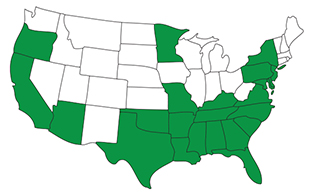
Purple Nutsedge
Cyperus rotundus
Purple Nutsedge is a perennial grassy weed that is also known as Purple Nut-grass, Nutgrass, Coco-sedge, Coco-grass or by its scientific name, Cyperus rotundus. This lawn weed is highly invasive.
Identify

Rhizomes

Sedge
Purple Nutsedge can be identified as a rapidly spreading, deep green, perennial grassy weed. It has three-ranked basal leaves, which are flat or slightly corrugated. The basal leaves are usually shorter than the flowering stem, abruptly tapering at the tip. This lawn weed also has a purple to reddish-brown seed head, formed at the end of a triangular stem. Purple Nutsedge produces oblong tubers that are covered with hairs. These tubers can be found connected by rhizomes and are bitter in taste.
Life Cycle
This lawn weed is often found growing in croplands, lawns and landscaping areas. Purple Nutsedge can be found in various parts of North America. These perennial grassy weeds can germinate and spread from seeds, but they also produce a root structure (tubers, bulbs or corms) that can birth new weeds from your lawn's surface (using stolons) or from underground (using rhizomes). Perennial grassy weeds live two or more years and have a deeper root structure that can give rise to new weeds—even if you no longer see the weeds in your lawn.

Control
Purple Nutsedge is commonly a lawn weed infesting poorly drained soils, so cultural weed control methods—including turf irrigation and water management—can help prevent this grassy weed from spreading. For effective weed removal, professionally selected and applied weed control treatments are your best bet for eradication.







